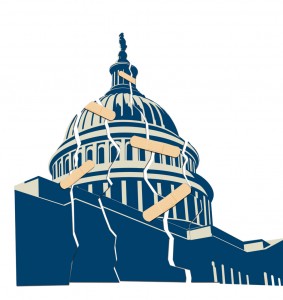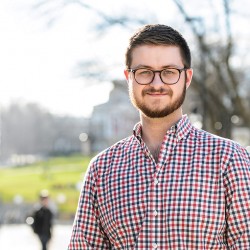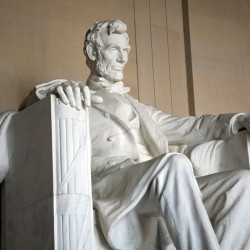Does Democracy Work?
“Democracy is the worst form of government except for all those other forms that have been tried,” Winston Churchill once said.
Even as someone who has devoted his professional life to studying and teaching about democracy, I often find it to be inefficient, messy, and exasperating. The behavior of Republicans and Democrats in the U.S. Congress is more polarized now than it was in the years immediately following the Civil War — a time when we were literally trying to kill each other. Less than a fifth of Americans say they are satisfied with “the way things are going” in the country, compared to nearly 70 percent expressing satisfaction with the American experiment back in 2000.
On the other hand, as Churchill was implying, democracy is also the most successful form of government the world has ever known. In the United States, our republican democracy allows us to select our leaders and then decide if we want them to continue to represent us for another term.
As frustrating as our democracy is, does it work? For our lawmakers, democracy requires compromise, communication, and clear choices that compete for our popular support. By these criteria, scholars Thomas Mann and Norman Ornstein have concluded that Congress is a bitterly divided, stalemated, “broken branch” of government. And scholars of the presidency have found that the president — considered the leader of the free world — is almost never able to meaningfully change public opinion. Indeed, if we examine our lawmakers and leaders, recent evidence shows that our democracy is not performing as well as we would like.
At the level of the mass public, democracy requires participation and the knowledge to make choices that maximize our chances of getting what we want. The main architect of the U.S. Constitution, James Madison, wrote, “[A] popular Government, without popular information, or the means of acquiring it, is but a Prologue to a Farce or a Tragedy; or perhaps both.”
In other words, democracy requires that citizens have access to information that helps them to make choices about how best to govern themselves. By the access-to-information standard, things have never been better. The digital revolution has brought the world to our doorstep. Using only our phones, we can live-stream breaking news, look up past stories on topics that interest us, and immediately share what we have learned via Facebook and Twitter. By the knowledge standard, Americans perform much more poorly. It is certainly true, and probably advisable, that most citizens do not wake up in the morning asking, “How do I hold my government accountable today?” But our understanding of both current affairs and the process of politics is thin. Scholars have found that our distaste for the process of politics leads to disengagement from the system. Civic education, these scholars argue, needs to include civic education along with barbaric education that tells the truth about political involvement: it is contentious, messy, requires compromise with your opponents, and often ends with your side losing. The more realistic we can be about the experience of political participation, the more likely people will keep participating when times get tough.
The rubber meets the road in our assessment of how well democracy works when we try to understand how well our elected leaders are representing us. Indeed, as the political scientist V.O. Key wrote in 1961, “Unless mass views have some place in the shaping of policy, all the talk about democracy is nonsense.” But what are mass views? My own research suggests that it’s very difficult to put our finger on the will of the people.
In our forthcoming book, Beyond the Left-Right Divide, Indiana University’s Ted Carmines, Kent State University’s Mike Ensley, and I examine the consequences a democracy faces when the electorate organizes its attitudes differently than elected officials do. Put simply, Republicans and Democrats in Washington, D.C. — indeed, in most state legislatures — are divided along a single left-right dimension in which Democrats support policies on the ideological left while Republicans favor policies on the ideological right. Their differences cover a wide range of issues from the economic (such as tax cuts and health care) to the social (such as abortion and same-sex marriage).
The public does not organize its attitudes so neatly. Individuals have views ranging from liberal to moderate to conservative on both economic issues and social issues. While these two issue dimensions essentially overlap for elected officials, they are distinct for those of us living and working from sea to shining sea. Some people have attitudes that are conservative across both dimensions — these folks favor things such as lower taxes and government regulation of traditional marriage. Others have preferences that are liberal across both dimensions; these individuals prefer to see more government regulation of the economy, but less regulation in the bedroom.
But it doesn’t end there. Some people are libertarian. They prefer that the government stay out of regulating the economy and private lives. Populists are just the opposite. They want a strong economic safety net provided by the government and strong government regulations on social-cultural issues. Finally, some people are just plain ol’ moderates who have attitudes somewhere in the middle.
While those who are liberal or conservative across both economic and social issues are just as polarized from each other as our elected officials, libertarians, populists, and moderates are stuck in between — pulled in different directions by a system of government run by two major political parties that do not perfectly represent their views across both sets of issues.
Liberals and conservatives behave far differently from libertarians, populists, and moderates in the American political system. They have strong partisan identities, are more polarized, watch more partisan news on cable channels, engage in higher levels of political participation, and cast more party-line ballots on Election Day. Libertarians, populists, and moderates participate less, have less-defined partisan attachments, split their tickets between the parties in the voting booth, and feel more disenchanted with our government.
Yet liberals, conservatives, libertarians, populists, and moderates are alike in their propensity to vote. Voter turnout in the United States has been much maligned — after all, only 58 percent of the voting-eligible population cast ballots in the 2012 presidential election. But things are better than they used to be: the turnout in the last three presidential elections was higher than in each of the previous eight. Why? Candidates are better able to target voters than they were in previous decades. Moreover, once people start voting, it becomes a habitual act. Social media can foster voter turnout, too: a recent study showed that people were more likely to vote if they saw in their Facebook newsfeeds that their friends had voted.
Do elections matter? Research shows that they do. People do a pretty good job of selecting candidates who most closely match their preferences, and the candidates who win elections make serious efforts to pass laws they said they would pass.
On balance, representation is alive and well in the United States. Our talk of democracy, then, is not nonsense — even though it can be maddening.
Michael W. Wagner is an assistant professor in the UW–Madison School of Journalism and Mass Communication and is affiliated with the Department of Political Science. His research and teaching centers on how well democracy works.
Published in the Fall 2014 issue




Comments
Katherine Fulkerson October 14, 2014
Do elections matter? Research shows that they do. People do a pretty good job of selecting candidates who most closely match their preferences, and the candidates who win elections make serious efforts to pass laws they said they would pass.
We talking about the same political system here? This may have been at least somewhat true pre-Citizens United, I certainly don’t see any basis for this assertion in the current political reality of government-up-for-auction masquerading as democracy.
Jeffrey John Lange October 15, 2014
I’m with Katherine on this one.
See the widely reported work of Princeton’s Martin Gilens and Northwestern’s Benjamin Page which compared American’s polled preferences with what actually occurred in 1,779 instances of government policy-making. (This, over 20 years, at the federal level.)
Gilens and Page found that ordinary citizens have no influence over what their government does.
It’s maybe not surprising that low-income Americans seemed to have no influence. But neither did middle-class Americans.
Only economic elites and business interest groups were shown to have influence.